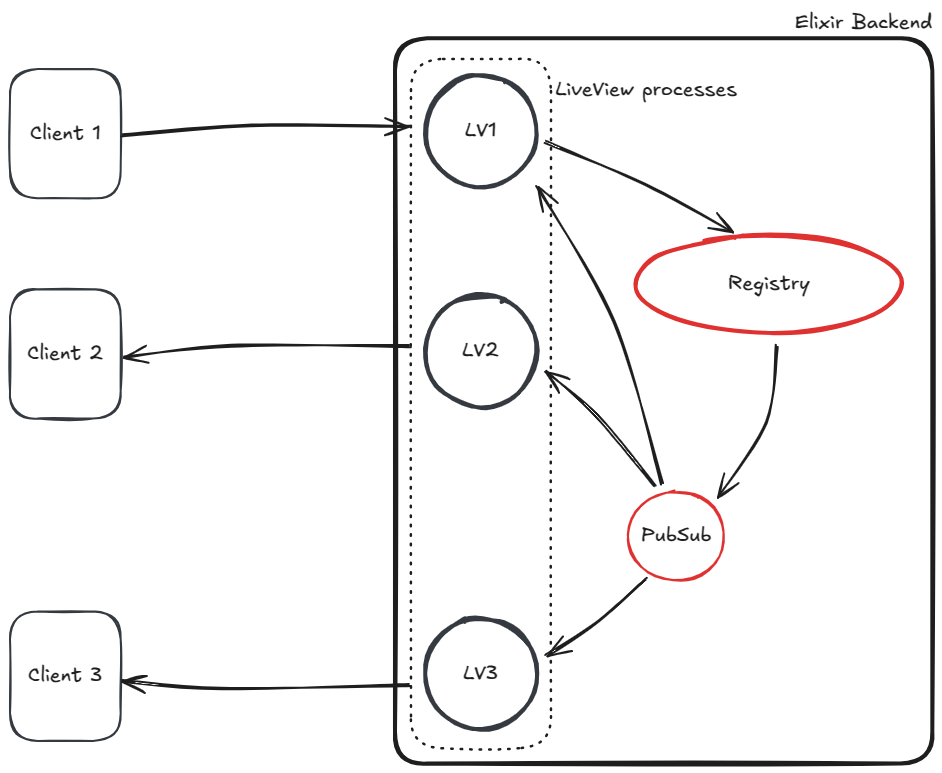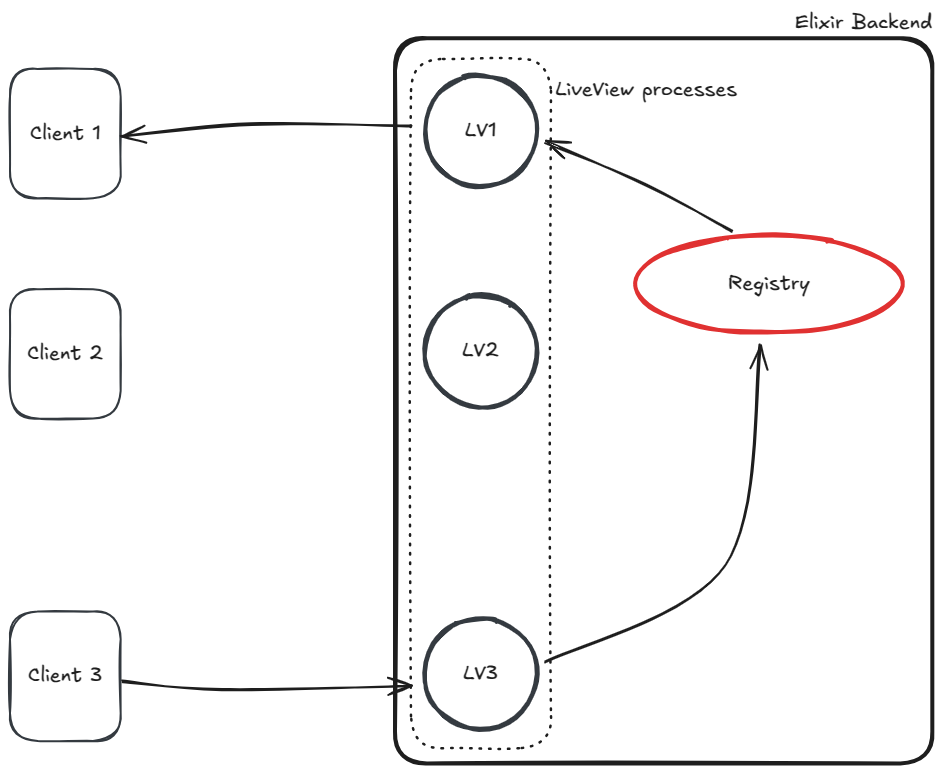
Exchanging messages between clients when using Phoenix LiveView
Table of Contents
A bit of context
While developing a small application for an internal demo, we found that we needed to exchange messages between the clients using the application (the description of which could be another blogpost on its own).
The backend we decided to use to support the application was based on Elixir, in particular on Phoenix LiveView. The exchange of messages between clients is not available out-of-the-box, but as we found out it is relatively easy to implement and to tailor to one’s needs.
Elixir Phoenix and LiveView
As stated in the documentation, LiveViews are processes that receive events, update their state, and render updates to a page as diffs . To implement our solution, we took advantage mainly of the fact that LiveViews are processes in the erlang/Elixir sense, and that each client is connected to a different LiveView process, each one with its own state and life cycle.
Phoenix comes out of the box with a PubSub module that supports the excahge of broadcast messages between Elixir processes. But what’s special about Elixir processes? Each Elixir process has its own mailbox that maintains ordering. We can decide to interact with a process synchronously (meaning that we proceed when the process is done handling our message) or asynchronously (meaning that as soon as the message is in the mailbox, we can proceed). The mapping between Elixir process and system threads/processes is handled by the BEAM (Erlang VM) process, so we don’t have to worry about that.
From now on, when we talk about processes, we will refer to Elixir processes.
The solution
As we said earlier, we need to be able to deliver a message, generated from a web client (a browser in our case), either to one specific client or to all the active client at that moment. To support both these use-cases, we decided to introduce the concept of a Registry in our backend: a stateful process maintaining a list of all the active LiveViews in the system. Aside from that, we also took advantage of the PubSub module that comes out of the box with Phoenix and use it to implement the needed broadcast feature.
For the purposes of this blogpost, this is is the relevant sequence of events:
- a new client connects to the application (in our case
http://localhost:4000/client) - a new LiveView process is instantiated and connected to this client
- the new LiveView process registers itself to the
Registrymodule and subscribes itself to thePubSubmodule - when a new process registers itself (meaning there is a new user), the
Registrymodule sends a broadcast message using thePubSubmodule - the other active LiveView processes receive the broadcast message and relay it to the connected clients
- the connected clients send back a response message to their respective LiveView processes, that forward them to the
Registrymodule - all the responses have a specific recipient, so the
Registrymodule does not need to involve a broadcast message, and can target the correct LiveView process - the correct LiveView process relays the response message to the correct client
The points from 1. to 5. are representend in Figure 1, where client 1 is the new client connecting to the application. The broadcast message is sent by the Registry process using the PubSub module, to which all the LiveView processes are subscribed. Note that the process denoted by LV1 receives the broadcast message as well, but does not forward it to client 1 (forwarding a new user message to the newly connected client does not make sense in our context).
 Figure 1: broadcast message when a new client connects
Figure 1: broadcast message when a new client connects
The points from 6. to .8 are represented in Figure 2, where client 3 generates the response message for client 1. The message is sent to the LiveView process LV3 that uses the Registry to forward it directly to LV1 using the Registry. Finally, client 1 receives the response.
 Figure 2: unicast response message
Figure 2: unicast response message
Code snippets
Here we will collect the most interesting snippets of code for the application described in this article. The complete source code repository can be found here.
The Registry process
The Registry is a GenServer (a stateful process with a specific interface and life cycle).
In our implementation the domain API implemented by the module is composed by two functions send_client_info and send_client_response. Both send a cast message (async message) to the Registry process proper.
@impl true
def handle_cast({:send_client_info, payload}, state) do
%{id: client_session_id, pid: pid} = payload
new_state = add_client(state, client_session_id, pid)
broadcast_message = %{
event_type: :broadcast,
event_name: :new_user,
payload: payload |> Map.delete(:pid)
}
Phoenix.PubSub.broadcast(Demo.PubSub, get_topic(), broadcast_message)
{:noreply, new_state}
endWhen a :send_client_info message is received, the Registry process will first record the sender as a new client in its state, then prepare a broadcast message and send it to a specific topic using the PubSub module.
@impl true
def handle_cast({:send_client_response, payload}, state) do
%{
"client_session_id" => client_session_id,
"recipient" => recipient_session_id
} = payload
sender = get_client(state, client_session_id)
recipient = get_client(state, recipient_session_id)
forward_message(sender, recipient, :client_response, payload)
{:noreply, state}
end
defp forward_message(%Client{} = from, %Client{} = to, event_name, payload) do
Logger.debug("Forwarding message #{event_name} from #{inspect(from)} to #{inspect(to)}")
msg = %{event_type: :singlecast, event_name: event_name, payload: payload}
Process.send(to.liveview_pid, msg, [])
endWhen a :send_client_response message is received, the Registry process will search for the sender and recipient references in its state, then if the references have been correctly found, forward the message to the recipient with an info message (this is also an async message).
LiveView process registration to Registry and PubSub
After the LiveView page is correctly mounted, the client application pushes an event that is received by the LiveView process.
Hooks.Client = {
mounted() {
//... other stuff
//sending the first message after startup
this.pushEvent("client_helo", {
payload: { name: `new-user-${rnd()}` },
});
},
};On the server side, in the matching event handler we collect the payload, generate a unique session id for the current LiveView process, subscribe to the relevant PubSub topic and notify the Registry of the existence of a new client. Note that we save the session id in the assigns for the socket in use.
def handle_event("client_helo", %{"payload" => payload}, socket) do
Logger.info("TestLive client_helo #{inspect(payload)} #{inspect(self())}")
# event triggered on the frontend
%{"name" => client_name} = payload
client_session_id = UUID.autogenerate()
Phoenix.PubSub.subscribe(Demo.PubSub, Registry.get_topic())
Registry.send_client_info(client_session_id, self(), client_name)
{:noreply, assign(socket, :client_session_id, client_session_id)}
endForwarding messages from LiveView to the client
To handle broadcast messages sent by the Registry via the PubSub module, we can use the handle_info callback in the LiveView module
def handle_info(
%{event_type: :broadcast, event_name: :new_user, payload: payload} = evt,
socket
) do
Logger.info("TestLive handle_info broadcast #{inspect(evt)}")
# Registry sent a broacast message about a new user.
# Let's forward the info to our specific client, if we are not the `new user`.
%{id: sender} = payload
%{client_session_id: current_session} = socket.assigns
socket =
maybe_forward_message(
sender != current_session,
socket,
evt.event_name,
payload
)
{:noreply, socket}
end
defp maybe_forward_message(true, socket, event_name, payload) do
socket |> push_event(event_name, payload)
end
defp maybe_forward_message(false, socket, _, _), do: socketWe can use the information sent by the Registry to determine if we need to forward the broadcast message to the client linked to the current LiveView process by comparing the sender id and the session id saved in the socket assigns. If they differ, we call push_event and forward the message to the client.
Handling the notification on the client
On the client side, this message is handled by registering a callback using handleEvent . In our application, the callback responds directly to the server with a direct client_response . Notice that a specific recipient is defined.
Hooks.Client = {
mounted() {
//custom events sent from the LiveView process
this.handleEvent(`new_user`, (newUserPayload) => {
console.log(`new user`, newUserPayload);
this.pushEvent("client_response", {
payload: {
message: `hello there ${newUserPayload.name}`,
recipient: newUserPayload.id,
},
});
});
//... other stuff
},
};Handling direct messages
As before, we use handle_event in the LiveView module to define how we want to handle the client_response message.
def handle_event("client_response", %{"payload" => payload}, socket) do
# event triggered on the frontend
%{client_session_id: current_session} = socket.assigns
%{"recipient" => recipient_session_id} = payload
Registry.send_client_response(current_session, recipient_session_id, payload)
{:noreply, socket}
endIn this case we want to forward the message using the Registry. The message is forwarded if both the sender and the recipent are saved in the Registry state.
def handle_cast({:send_client_response, payload}, state) do
%{
"client_session_id" => client_session_id,
"recipient" => recipient_session_id
} = payload
sender = get_client(state, client_session_id)
recipient = get_client(state, recipient_session_id)
forward_message(sender, recipient, :client_response, payload)
{:noreply, state}
end
defp forward_message(%Client{} = from, %Client{} = to, event_name, payload) do
Logger.debug("Forwarding message #{event_name} from #{inspect(from)} to #{inspect(to)}")
msg = %{event_type: :singlecast, event_name: event_name, payload: payload}
Process.send(to.liveview_pid, msg, [])
endThe receiving LiveView process defines another handle_info function clause to match this message.
def handle_info(%{event_type: :singlecast, event_name: event_name, payload: payload}, socket) do
Logger.info("TestLive handle_info siglecast #{inspect(event_name)} #{inspect(payload)}")
# Registry sent a direct message.
# Let's forward the info to our specific client, if it is meant for us (it should)
%{"recipient" => recipient} = payload
%{client_session_id: current_session} = socket.assigns
socket =
maybe_forward_message(
recipient == current_session,
socket,
event_name,
payload
)
{:noreply, socket}
endOn the client side, this message is handled as before with a matching handleEvent callback.
Conclusion
We have seen one way in which we can exchange messages between clients when LiveViews are used, both in a direct way or using broadcasting. The whole example is available here.
